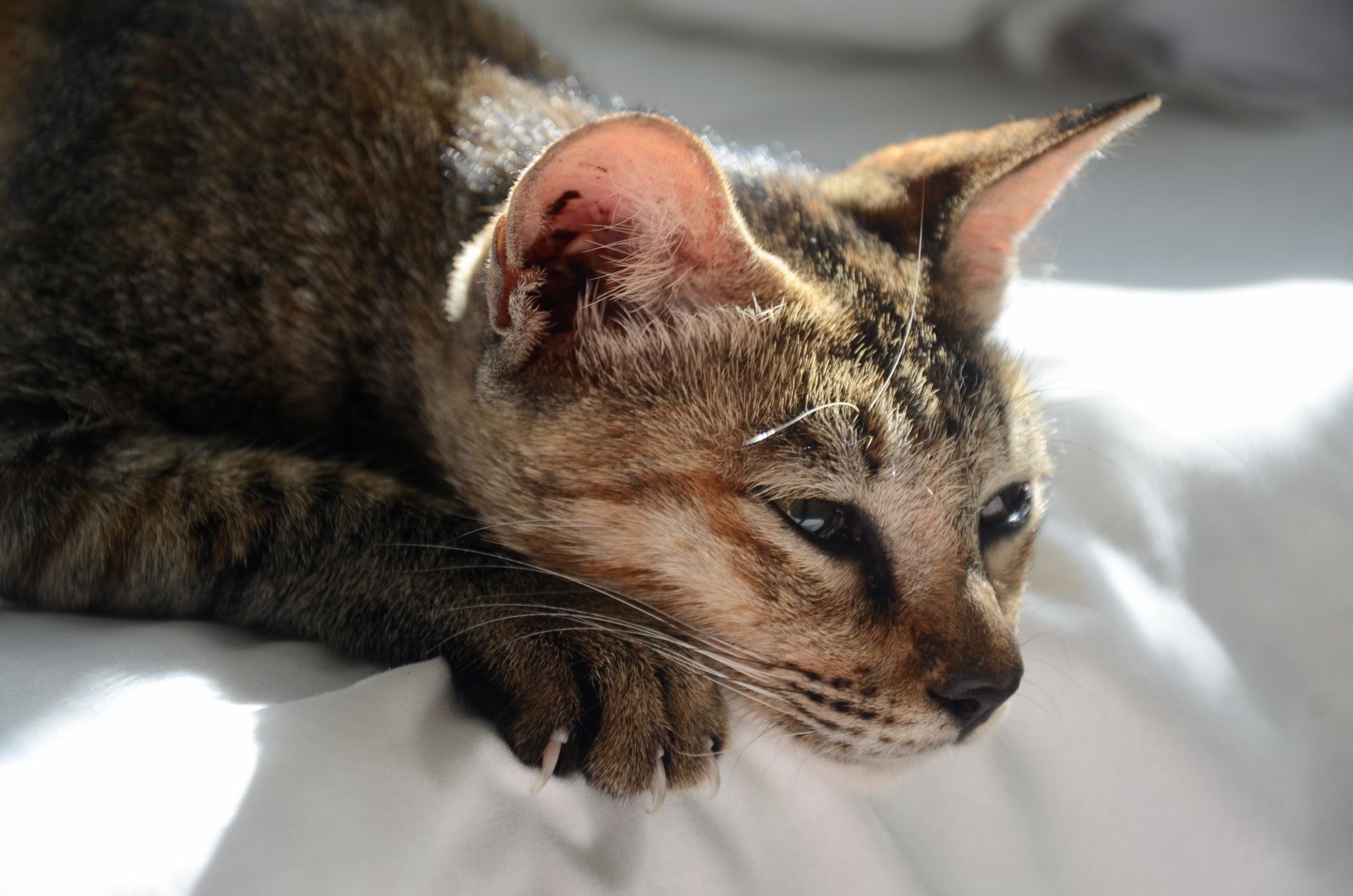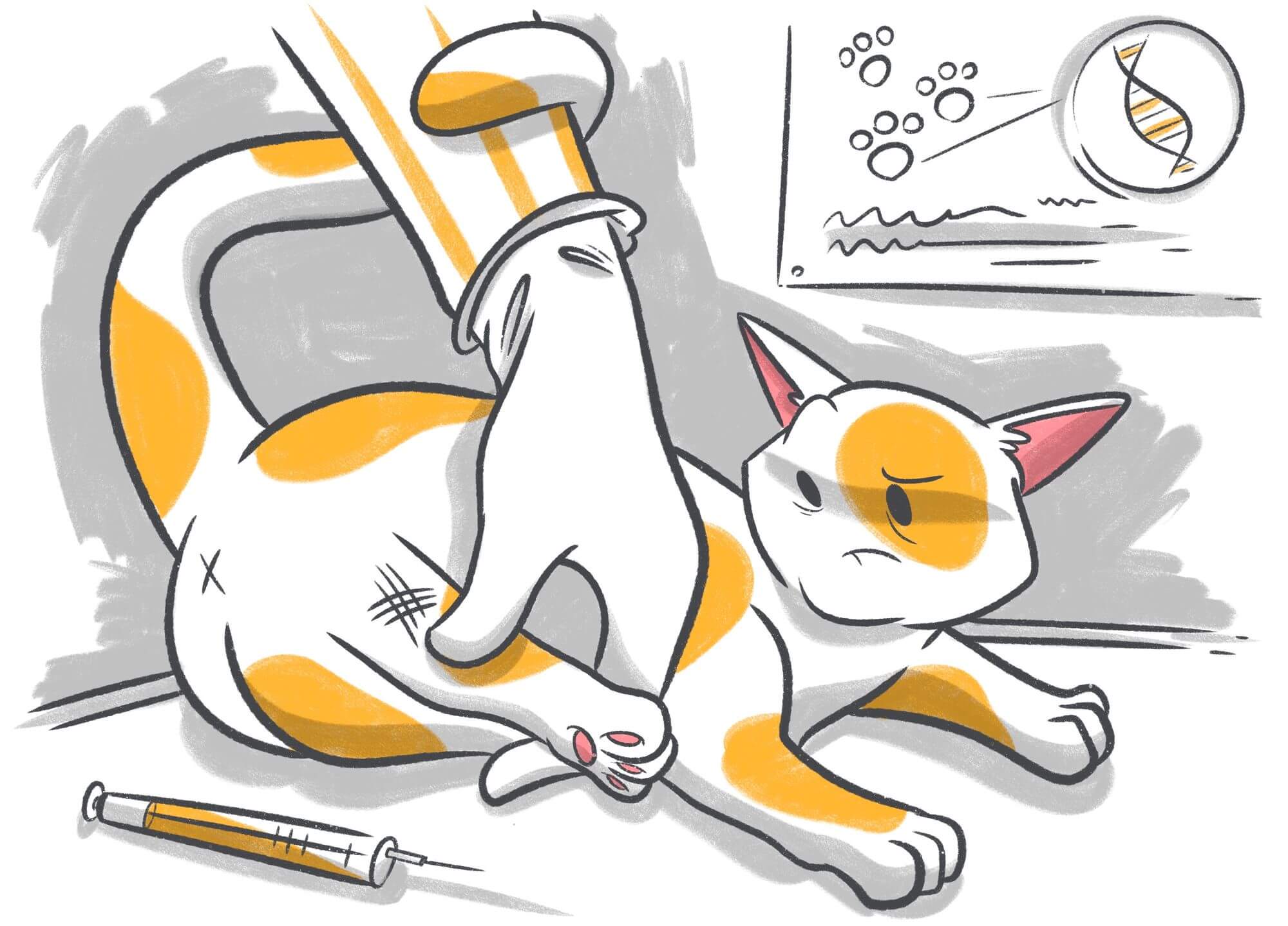Affecting between 2% and 3% of cats around the U.S., the Feline Leukemia Virus (FeLV) is among the most widespread infectious diseases in cats. The condition can be fatal, as 85% of cats that are persistently infected with it sadly cross the rainbow bridge within 3 years of being diagnosed.
Stop Googling - Ask a Real Vet
FeLV often causes anemia as well as lymphoma. And because the virus suppresses a cat’s immune system, they also become predisposed to a variety of infections that could be life-threatening. The rate of infection goes up to 30% (which is significantly higher) in cats who have health issues or have a higher risk (more on this later) of getting the disease.
Exposure to FeLV, however, doesn’t mean that your cat’s future is bleak. Some cats can resist getting the infection even after being exposed. In some cases, the cats’ bodies can eliminate the virus before it enters their system. Nevertheless, FeLV is a serious condition with no known cure yet. In light of this, it is important to take measures, such as having your cat vaccinated, to help prevent them from getting the disease.
Content:
- Feline Leukemia Symptoms
- Transmission of Infection with Feline Leukemia
- Diagnosing Feline Leukemia Virus
- Treatment for Feline Leukemia Virus
- How Can the Emergency Fund Help with Treatment
- FAQ
- Conclusion
Feline Leukemia Symptoms
According to NCBI study, there are various ways in which FeLV can affect your cat’s body. For one thing, FeLV is the most common cause of cancer in cats. In addition, it can also cause disorders in the blood.
Not to mention, it may also lead to a deficiency in your cat’s immune system, threatening its ability to protect itself from various infections. As a result, common illnesses due to viruses, bacteria, fungi, and protozoa that don’t affect healthy felines that much may lead to serious health conditions in cats with FeLV.
In the early FeLV stages, many cats may not show any symptoms of the disease. However, as time passes, their health may deteriorate, and they may be more prone to recurring illnesses.
Below are several possible feline leukemia symptoms:
- Poor coat;
- Weight loss;
- Lack of appetite;
- Enlarged lymph nodes;
- Persistent diarrhea;
- Pale gums;
- Persistent fever;
- Gingivitis and stomatitis;
- Seizures;
- Neurological disorders;
- Eye conditions;
- Behavioral changes;
- Reproductive failure.
Detecting FeLV symptoms early may help in managing the condition as well as effectively treating other illnesses that it may cause. Having a good-quality pet camera, such as the Petcube Camera, is a worthy investment to be able to monitor your pet at all times. That way, you may be able to address any health issues early on.
Transmission of Infection with Feline Leukemia
"Is feline leukemia contagious?" you may be wondering. Yes, it is, but only among cats. It is not contagious to humans, dogs, or other animal species. Transmission of FeLV is passed from cat to cat through contact with the infected cat’s saliva, nasal secretions, urine, feces, blood, or an infected cat’s milk.
FeLV doesn’t live long without a host (a cat’s body) — probably not more than a couple of hours. Can a cat with feline leukemia live with other cats? Most commonly, the virus is transmitted through close contact with infected cats via mutual grooming and bite wounds from fights.
It may also be transmitted through shared litterboxes and feeding bowls. Meanwhile, an infected mother cat may also pass the virus either before the kittens are born or through the mother’s milk during nursing.
Cats who are most at risk of FeLV are those who have close contact with infected cats. These include cats who live with infected cats, cats who are allowed to go outside without supervision where they may get bite wounds from infected cats, and kittens with infected moms.
In general, kittens are more susceptible to getting infected than adult cats since adult cats have more developed immune systems. Despite this, adult cats are also susceptible to getting infected after a certain amount of exposure.
Diagnosing Feline Leukemia Virus
How to test for feline leukemia? You may be wondering: Is there a feline leukemia test that can detect the disease?
FeLV is often diagnosed through two types of blood tests: ELISA and IFA, which can both detect a certain protein in the virus named FeLV P27.
ELISA
The enzyme-linked immunosorbent assay (ELISA) test is often used for initial screening to detect free FeLV particles that are usually found in a cat’s bloodstream in early to late feline leukemia stages.
IFA
The indirect immunofluorescent antibody assay (IFA) test, on the other hand, is usually brought to a laboratory after getting a positive result on the ELISA test to confirm a FeLV diagnosis and to know if it has progressed to the later stages.
An IFA test can detect if there are particles of the virus in the white blood cells, which indicates FeLV in its later stages. Most of the cats that get a positive result in the IFA test stay infected for the rest of their lives and often have a poor prognosis. In some cases, a polymerase chain reaction (PCR) test may be performed to determine whether the bone marrow has also been affected by the disease.
Treatment for Feline Leukemia Virus

Like what was mentioned earlier, 85% of cats persistently infected with FeLV succumb within 3 years of being diagnosed. Despite this, regular check-ups at the vet and maintaining your cat’s health may help manage the condition as well as prevent illnesses and secondary infections. At the same time, cats with FeLV should stay indoors and be neutered.
At present, there is no cure for FeLV. Meanwhile, secondary infections may be addressed when they appear. For those with cancer, chemotherapy may be received. Unfortunately, if the bone marrow has been infected or if a cat already has widespread lymphoma, the prognosis doesn’t look good.
Since there is no cure for FeLV, it’s best to prevent this life-threatening disease. A vaccine is recommended to decrease the risk of your cat getting the virus, but the only sure way is to prevent your cat from being exposed to infected cats. It’s best to keep your cats indoors to prevent them from getting into fights with other cats who may be infected. If you allow your cat to go outdoors, make sure to supervise them and provide a secure enclosure if possible.
How Can the Emergency Fund Help with Treatment
Because the feline leukemia virus is complicated, especially in the later stages, it’s best to be prepared. One way to be prepared is to have a Pet Emergency Fund that covers veterinary bills during pet emergencies and, at the same time, gives you much-needed support in taking care of your pet.
Petcube’s Pet Emergency Fund is a great choice because not only do you get $3000 in an emergency for all your pets (regardless of age, breed, and medical history) at the time when you need it, but you also get access to a 24/7 online vet service where you can consult with your cat’s FeLV, for example. This would be a big help in addressing health concerns related to your cat’s FeLV or any other health condition that needs attention.
FAQ
Should a cat with feline leukemia be put down?
This can be very distressing, but consulting with your vet is recommended to determine the best course of action for your cat’s specific case. Some people decide to put down their cat to relieve their pet of any pain and prevent the spread of the virus.
Meanwhile, others strive to give their cats a happy and long life despite the disease. It is ultimately up to the owner to decide what course of action to take.
Is feline leukemia contagious to humans?
Feline leukemia is not contagious to humans, dogs, or other animals. It is only contagious to cats.
Feline leukemia life expectancy: how long can cats live with the disease?
While it may vary, the median life expectancy for cats with persistent FeLV is 2.5 years.
Conclusion
Finding out that your cat has FeLV may be devastating. However, cats with FeLV can still live normally and live longer with proper management. Upon diagnosis, regular monitoring and checkups with the vet are important to be able to manage the disease.
If your cat shows any signs or symptoms of illness, it’s best to consult with your vet immediately to determine the best course of action.
Was this article helpful?
Help us make our articles even better









